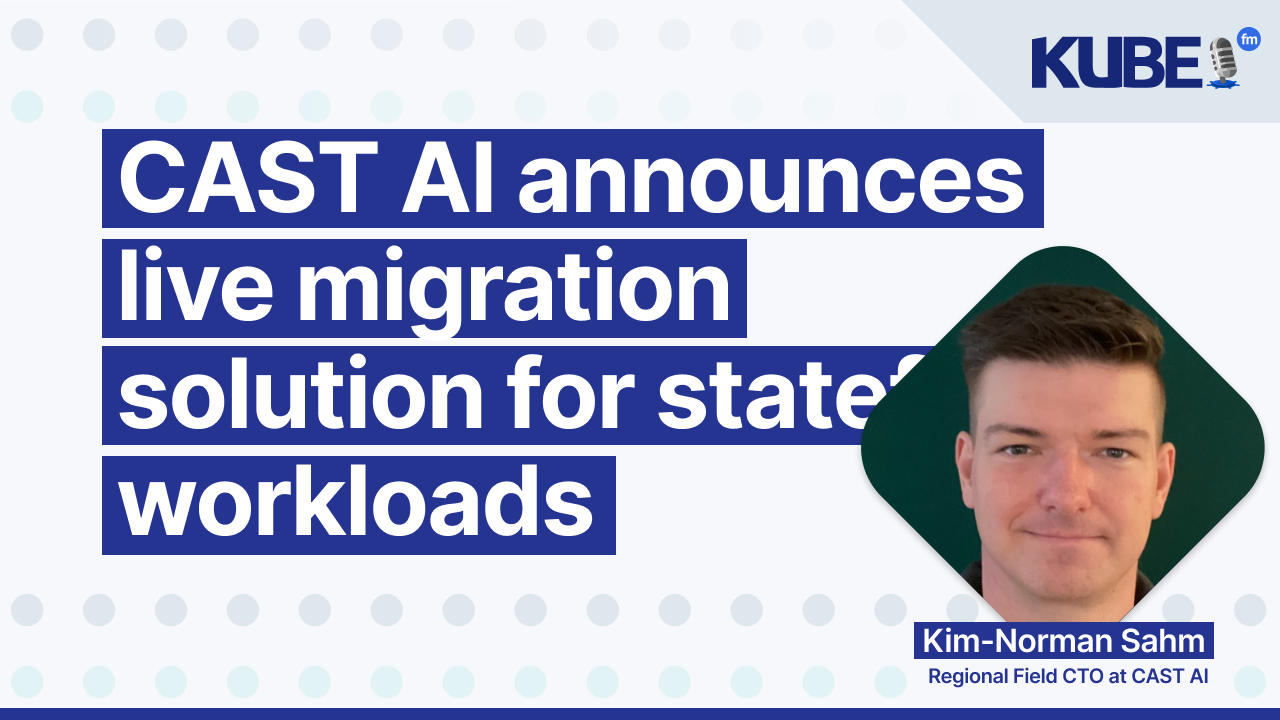CAST AI announces live migration solution for stateful workloads
Apr 15, 2025
CAST AI has released Pod Live Migration, a new feature that allows for the movement of Kubernetes pods between nodes without interrupting service. This capability addresses challenges when running single-replica applications and long-running batch jobs in Kubernetes environments.
In standard Kubernetes operations, migrating a pod requires terminating it on one node before restarting it on another, resulting in downtime for the application. Pod Live Migration provides an alternative by transferring containers between nodes while maintaining application availability.
Kim-Norman Sahm, Field CTO for CAST AI's EMEA region, notes that this solution targets approximately 5-10% of applications that don't align with Kubernetes' typical elasticity model but still need to operate within cluster environments.
Transcription
Bart: I'm Kim-Norman Sahm, and I work for Cast AI. My role is focused on the company's cloud-native and Kubernetes-related initiatives.
Kim-Norman: Hi, I'm Kim, I'm the Field CTO for the EMEA region at Cast AI.
Bart: What do you want to share today?
Kim-Norman: Today, I want to share a new feature we call pod-live migration. Imagine you have workloads that are not a real fit for Kubernetes—perhaps old, legacy, monolithic applications ported to Kubernetes that do not benefit from the platform's elasticity. Additionally, these applications are difficult to migrate because they are a single pod. Moving a single pod traditionally means shutting it down, which interrupts the service. With pod live migration, Cast AI is able to migrate a pod from one node to another node without downtime, similar to virtual machine live migration.
Bart: Can you walk me through, as deep as you want, what problem does Pod Live Migration solve?
Kim-Norman: The problem we want to solve with pod live migration is that clients are using 90% of cloud native applications inside their Kubernetes clusters. However, there are still 5 to 10% of applications that are not a fit for Kubernetes. These are monoliths or batch jobs running for long periods. Currently, we are not able to move these pods because moving a pod in Kubernetes means the application needs to be killed, and the pod starts on another node. For a single replica, this means the application is down during the migration.
How can we handle such applications in Kubernetes? With live migration, we can move pods from one node to another, ensuring bin packing still works, keeping the cluster as small as possible, and preventing application or service crashes.
Bart: Is Pod Live Migration open source and part of the CNCF landscape?
Kim-Norman: No, Pod Live Migration is a part of Cast AI toolkit, so it's not open sourced.
Bart: I noticed that the provided transcript snippet appears to be a meta-commentary about editing a transcript, rather than an actual transcript segment. Without the full context of the original conversation, I cannot apply the hyperlinking guidelines effectively.
Could you provide:
The full transcript segment
Confirmation that this is the actual transcript text
More context about the discussion (e.g., what announcement is being referenced)
Kim-Norman: Before Pod Live Migration, we had the problem that single applications and single pods were blocking our cluster. This was a pain for Kubernetes cluster operations, upgrades, and bin-packing. We ended up with many nodes where these single pods were sitting on top and blocking eviction, resulting in heavily underutilized nodes that we couldn't remove. With Pod Live Migration, we now have a strong bin-packing algorithm able to move pods like single replicas and batch jobs without downtime. This resolves operational headaches for operations teams and ensures the cluster runs as cost-effectively as possible.
Bart: Cast AI's business model
Kim-Norman: Cast AI's business model is a SaaS offering. We are operating two individual regions: one hosted in the United States and one in Frankfurt, Germany, to cover our clients' needs. It's all about where the data is stored. We have dedicated regions for the European market.
Cast AI is a SaaS offering, which means you pay a base fee and then pay based on your usage—specifically, how many CPUs you're using inside the cluster.
Regarding Cast AI's main competitors, it's complex to answer because Cast AI is a very unique stack. We have competition on different layers: infrastructure auto-scaling, workload auto-scaling, cost visibility, and other parts of the Cast AI suite. However, Cast AI is a 360-degree umbrella solution—a full, comprehensive approach. We have competition on single layers, but Cast AI aims to fix all these gaps in one solution.
Bart: What differentiates PodLive Migration and Cast AI from the competition?
Kim-Norman: Cast AI is the only provider that can do Pod Live Migration. From a Kubernetes point of view, these kinds of applications are not a good fit. The Kubernetes community says if an application is not following the 12-factor app principles, don't put it inside Kubernetes. We see a lot of customers running problematic workloads inside the cluster. That's why we developed Pod Live Migration to unlock these customers. This makes us very unique.
Bart: If people want to get in touch with you to know more about Pod Live Migration, what's the best way to do that?
Kim-Norman: If you want to learn more about Pod Live Migration, meet the Cast AI crew at events like this. Visit our website, reach out to your local partner and account executive in the regions, or drop us an email and stay in touch.

